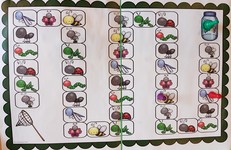 |
| Angelika/Mike Schilli |
|
Angelika Due to my job change, I'm now teaching the subject "Social Emotional Learning" in a second-grade class every day. It's a 40-minute lesson on positive social behavior. We have core topics that we need to cover in a school year, such as peaceful conflict resolution, fostering class community and friendships, strategies for reducing aggression, learning to lose in games, etc., but we also have a lot of freedom in how we approach the individual topics and what materials we want to use.
Through my previous job with autistic children and by leading social groups for these children, as well as the summer camps I designed, I already have many materials and activities at my disposal that I can use in my second-grade class. However, when my colleague who taught elementary school subjects abruptly resigned in February, I also took over social studies, science, and art for a few weeks until we found a substitute teacher to cover until the end of the school year. Since I am not a trained elementary school teacher, I had to familiarize myself with the entire subject matter.
In the US, there is something like a curriculum ("Common Core Standards") in each state, which outlines what needs to be taught in each subject and what the children must have learned by the end of the school year. I was only able to take on this role because we are a private school and not a public one, as in public schools, you can only teach if you have a California Teaching Credential. By the way, the subject "Social Emotional Learning" is generally not an official subject in schools. This is something very special about our school.
So I browsed through the teaching materials we have at our school, but of course, I also consulted the internet to make the lessons interesting for my students. The internet portal Teachers Pay Teachers is my absolute favorite. On the website, teachers can find materials and fully developed lesson plans for purchase, for a small fee. The idea is brilliant because creating materials involves a significant amount of time. Additionally, everyone benefits from the ideas of others. For example, I often buy materials from the site, which I then use as a basis but modify for my purposes and my students.
The idea came from Paul Edelman, a teacher from New York, who founded "Teachers Pay Teachers" in 2006. Meanwhile, three million prepared lesson plans or other materials are available for sale on the portal. Five million teachers use the service. The materials are organized by subject and grade level. To purchase materials on the site, the buyer only needs to register, which is free, and can then shop using a credit card or PayPal. Most materials are simply downloaded in PDF format and are ready to print. Depending on the extent of the offered materials, they often cost between $2.50 and $5. That is usually what I spend. There are also entire learning units available for purchase, which can cost $15 or even up to $30.
To sell something on the site, the interested party must register as a seller. There are two models available. One is free, while the other costs the seller $59.95 per year. If the teacher who wants to offer their products on the site chooses the free option, "Teachers Pay Teachers" charges a fee of 30 cents per transaction, and the teacher receives 55% of the sale price. The second option, with an annual membership fee, increases the seller's share to 80%, and the transaction fee drops to 15 cents for orders under $3. There are also other rules that sellers must follow, such as ensuring that the materials they sell on "Teachers Pay Teachers" are not made available for free elsewhere on the internet by them. Incidentally, many also offer free items on the portal.
There are some teachers who have now given up classroom teaching and use "Teachers Pay Teachers" as their main source of income because it is more profitable for them, although this is probably the exception. Most, however, earn a decent amount of pocket money from it. By the way, there are critical voices that say the exchange of materials between colleagues should not cost anything. I don't see it that way. Why shouldn't one be compensated for something they have spent hours working on?













